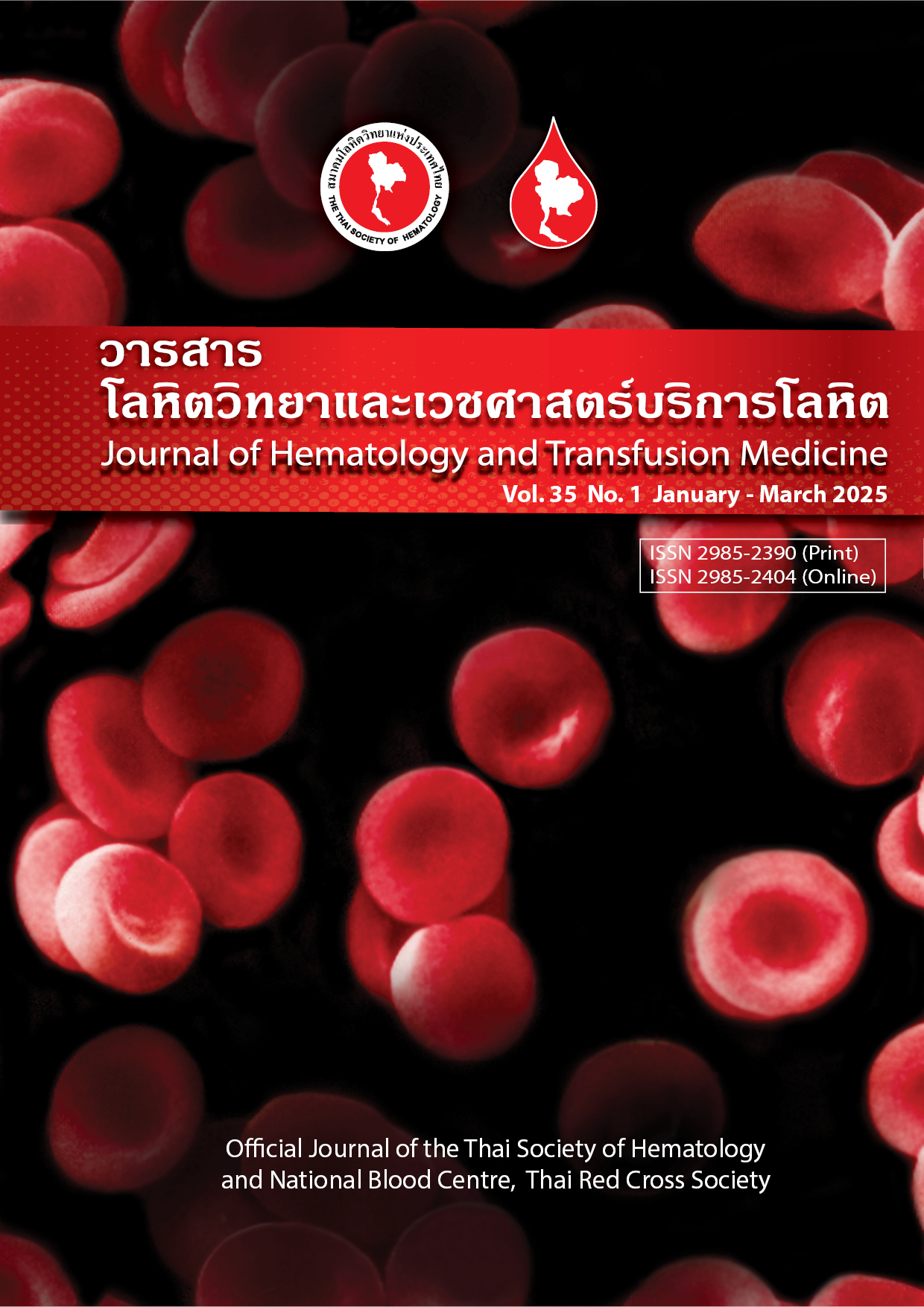Validity and reliability of self-administered Thai Pediatric Bleeding Assessment Tool (Pediatric-BAT) application to predict the risk of bleeding in pediatric bleeding disorders
DOI:
https://doi.org/10.69898/jhtm.35.2024.271292Keywords:
Pediatric Bleeding Assessement Tool (BAT), Pediatric Bleeding Questionnaire (PBQ), self-administered, bleeding riskAbstract
Background: Congenital and acquired bleeding disorders present with various symptoms ranging from mild to severe manifestation. In recent years, attempts have been made to apply bleeding histories in questionnaires to predict the risk of bleeding and describe the symptoms’ severity. The Pediatric Bleeding Assessment Tool (BAT) is a pediatric-specific bleeding checklist set that has been accepted worldwide and was translated to multiple languages including Thai.
Objectives: (a) The study aimed to test the validity and reliability of the self-administered BAT and compare with the professional-administered BAT among Thai children with bleeding disorders, and (b) to descriptively evaluate severity using the self-administered BAT.
Method: This is a descriptive study of patients receiving a diagnosis of bleeding disorders treated at the King Chulalongkorn Memorial Hospital between 2019 and 2020. The patients were interviewed by a physician using the Thai version of the BAT application followed by a self-administered assessment over the next two weeks. Results were analyzed using mean and test-retest reliability by intra-class correlation (ICC).
Result: Totally, 41 eligible pediatric and adolescent patients, a median age of 10 years (ranged 2-20) were enrolled (17 with von Willebrand disease (VWD), 8 with severe hemophilia A, 3 with congenital factor VII deficiency and 13 with immune thrombocytopenia (ITP)). The total mean scores of self- and professional-administered BAT were 8.88 and 8.98 respectively (p = 0.819). However, subgroup analysis showed statistically significant differences between the two groups in diseases that have high BAT scores (severe hemophilia A and chronic ITP). The mean duration of the interview was 9.68 and 3.51 minutes, respectively (p <0.001). The score was also shown to depend on the disease and severity descriptively.
Conclusion: Self-administered BAT application is comparable with interviews by physicians in identifying the bleeding disorders and evaluating severity, but higher score need to be interpreted more carefully. The nondiagnosed mild bleeder may be encouraged to find medical attention, and known bleeders could also assess any severity change by themselves.
Downloads
References
Bowman M, Riddel J, Rand ML, Tosetto A, Silva M, James PD. Evaluation of the diagnostic utility for von Willebrand disease of a pediatric bleeding questionnaire. J Thromb Haemost. 2009;7:1418-21.
Tosetto A, Rodeghiero F, Castaman G, Goodeve A, Federici AB, Batlle J, et al. A quantitative analysis of bleeding symptoms in type 1 von Willebrand disease: results from a multicenter European study (MCMDM-1 VWD). J Thromb Haemost. 2006;4:766-73.
Rodeghiero F, Tosetto A, Abshire T, Arnold DM, Coller B, James P, et al. ISTH/SSC bleeding assessment tool: a standardized questionnaire and a proposal for a new bleeding score for inherited bleeding disorders. J Thromb Haemost. 2010;8:2063-5.
Shahriari M, Karimi M. Are Bleeding Scores Predicting Severity and Outcome in Hemophilia and Rare Bleeding Disorders? Blood. 2016;128:4801.
ISTH/SCC. ISTH-SSC Bleeding Assessment Tool 2011 [Available from: https://www.isth.org/page/reference_tools.
Pakdeeto S, Natesirinilkul R, Komwilaisak P, Rand ML, Blanchette VS, Vallibhakara SA, et al. Development of a Thai version of the paediatric bleeding assessment tool (Thai paediatric-BAT) suitable for use in children with inherited mucocutaneous bleeding disorders. Haemophilia. 2017;23:e539-e42.
Kaur D, Kerlin BA, Stanek JR, O'Brien SH. Use of electronic self-administered bleeding assessment tool in diagnosis of paediatric bleeding disorders. Haemophilia. 2021;27:710-6.
Downloads
Published
Issue
Section
License
Copyright (c) 2024 Journal of Hematology and Transfusion Medicine

This work is licensed under a Creative Commons Attribution-NonCommercial-NoDerivatives 4.0 International License.



